
The United States Capitol, often called the Capitol or the Capitol Building, is the seat of the United States Congress, the legislative branch of the federal government. It is located on Capitol Hill at the eastern end of the National Mall in Washington, D.C. Although no longer at the geographic center of the national capital, the U.S. Capitol forms the origin point for the street-numbering system of the district as well as its four quadrants.
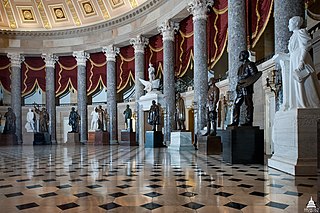
The National Statuary Hall is a chamber in the United States Capitol devoted to sculptures of prominent Americans. The hall, also known as the Old Hall of the House, is a large, two-story, semicircular room with a second story gallery along the curved perimeter. It is located immediately south of the Rotunda. The meeting place of the U.S. House of Representatives for nearly 50 years (1807–1857), after a few years of disuse it was repurposed as a statuary hall in 1864; this is when the National Statuary Hall Collection was established. By 1933, the collection had outgrown this single room, and a number of statues are placed elsewhere within the Capitol.
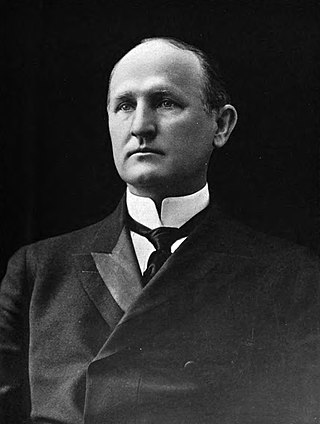
Charles Brantley Aycock was the 50th governor of the U.S. state of North Carolina from 1901 to 1905. After starting his career as a lawyer and teacher, he became active in the Democratic Party during the party's Solid South period, and made his reputation as a prominent segregationist.

William Franklin Graham Jr. was an American evangelist, an ordained Southern Baptist minister, and a civil rights advocate whose broadcast and live sermons became well known internationally in the mid-to-late 20th century. During a career spanning six decades, Graham was a prominent evangelical Christian figure in the United States.

The National Statuary Hall Collection in the United States Capitol is composed of statues donated by individual states to honor persons notable in their history. Limited to two statues per state, the collection was originally set up in the old Hall of the House of Representatives, which was then renamed National Statuary Hall. The expanding collection has since been spread throughout the Capitol and its Visitor's Center.
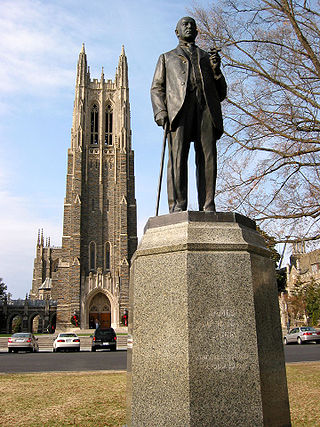
Charles Keck was an American sculptor from New York City, New York.

The North Carolina State Capitol is the former seat of the legislature of the U.S. state of North Carolina which housed all of the state's government until 1888. The Supreme Court and State Library moved into a separate building in 1888, and the General Assembly moved into the State Legislative Building in 1963. Today, the governor and his immediate staff occupy offices on the first floor of the Capitol.
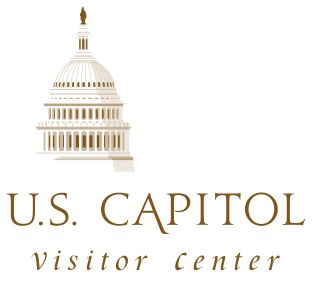
The United States Capitol Visitor Center (CVC) is a large underground addition to the United States Capitol complex which serves as a gathering point for up to 4,000 tourists and an expansion space for the U.S. Congress. It is located below the East Front of the Capitol and its plaza, between the Capitol building and 1st Street East. The complex contains 580,000 square feet (54,000 m2) of space below ground on three floors. The overall project's budget was $621 million.

The United States Capitol building features a central rotunda below the Capitol dome. Built between 1818 and 1824, the rotunda has been described as the Capitol's "symbolic and physical heart".
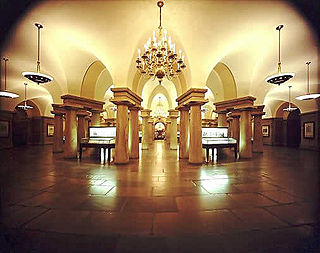
The United States Capitol crypt is the large circular room filled with forty neoclassical Doric columns directly beneath the United States Capitol rotunda. It was built originally to support the rotunda as well as offer an entrance to Washington's Tomb. It currently serves as a museum and a repository for thirteen statues of the National Statuary Hall Collection.
Charles B. Aycock High School (CBA) is a public high school in Wayne County, North Carolina, United States, that opened in 1961. The school's physical address is Pikeville, North Carolina. This area of North Carolina is near the birthplace of Governor Charles Brantley Aycock. During Governor Aycock's term, he advocated improving North Carolina's public schools. Even after his term as governor, he continued to work on the improvement of schools in the country. It is because of Governor Aycock's passion for public education for only white students that the school got its name.
Events from the year 1859 in the United States.
The Aycock Birthplace, also known as the Charles B. Aycock Birthplace, is a historic home in Wayne County, North Carolina, and a historic site belonging to the North Carolina Department of Natural and Cultural Resources' Historic Sites division. The property was the location of the birth of Governor Charles Brantley Aycock in 1859, and exhibits at the historic site serve to tell the story of the Governor's political career and the education reforms he enacted while in office. It was built about 1840, and is a one-story weatherboard dwelling on a brick pier foundation. It has a gable roof and exterior end chimneys.

Jefferson Davis, created by Henry Augustus Lukeman, is a bronze sculpture of Jefferson Davis – a U.S. Senator, U.S. Secretary of War, plantation owner and the only President of the Confederate States of America – commissioned by the U.S. State of Mississippi for inclusion in National Statuary Hall Collection at the United States Capitol's National Statuary Hall, in Washington, D.C. The statue was controversial at the time of its unveiling and there have been multiple efforts to remove it from the Capitol since 2015.

The National Statuary Hall Collection holds statues donated by each of the United States, portraying notable persons in the histories of the respective states. Displayed in the National Statuary Hall and other parts of the United States Capitol in Washington, D.C., the collection includes two statues from each state, except for Virginia which currently has one, making a total of 99.
Huey Long is a 1941 bronze sculpture of Huey Long by Charles Keck, installed in the United States Capitol, in Washington, D.C., as part of the National Statuary Hall Collection. It is one of two statues donated by the state of Louisiana.

George Washington was a life-size marble statue of George Washington, done in the style of a Roman general, by the Venetian-Italian Neoclassical sculptor Antonio Canova. Commissioned by the State of North Carolina in 1815, it was completed in 1820 and installed in the rotunda of the North Carolina State House on December 24, 1821. The building and the statue were destroyed by fire on June 21, 1831. This work was the only one created by Canova for the United States.

There are several works of art in the United States Capitol honoring former leaders of the Confederate States of America and generals in the Confederate States Army, including seven statues in the National Statuary Hall Collection, busts and portraits.

The 1900 North Carolina gubernatorial election was held on August 2, 1900. Democratic nominee Charles Brantley Aycock defeated Republican nominee Spencer B. Adams with 59.57% of the vote. The election started a string of 18 consecutive elections in which the Democratic nominee won the Governor's office. The state would not elect another Republican as governor until James E. Holshouser, Jr. won in 1972.













